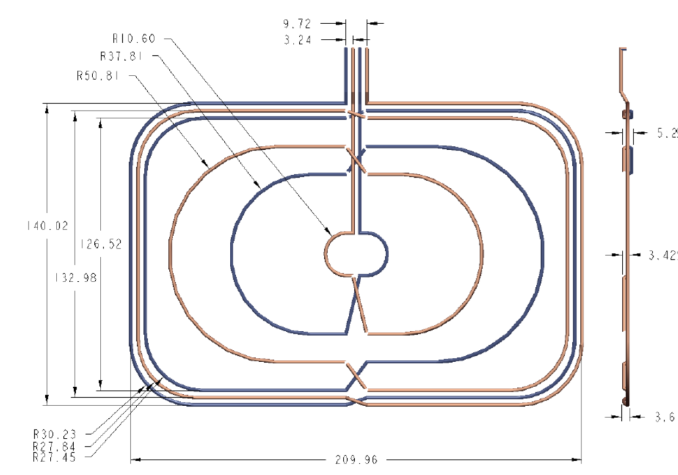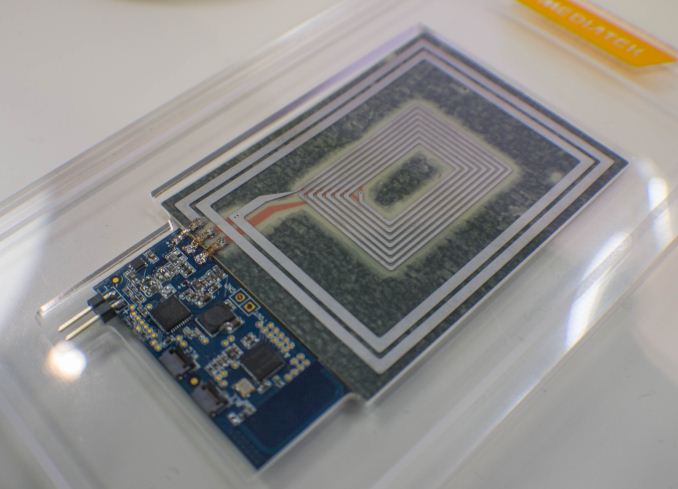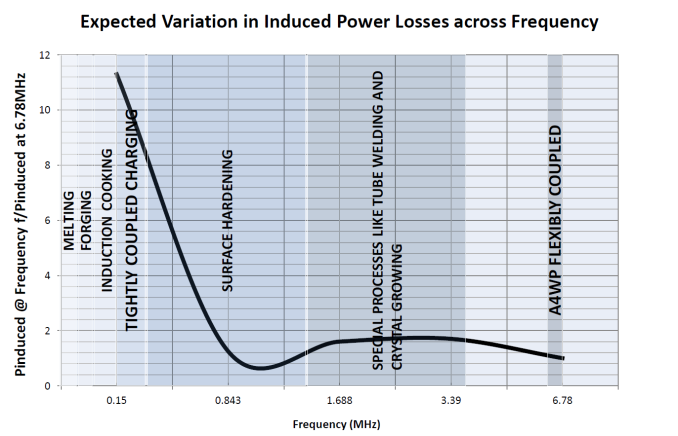The State of Wireless Charging Standards in Mobile
by Andrei Frumusanu on April 2, 2015 8:00 AM ESTRezence Resonance Charging
Earlier we saw the distinction between tightly coupled (TC) and loosely coupled (LC) induction charging systems. While A4WP’s Rezence system is called a magnetic resonance charging system, the basic principle is still based on magnetic induction. The critical difference between Qi and Powermat standards is that it is a Rezence is based on a loosely coupled coil system.
Inductive power frequencies and use-cases (Source)
A4WP systems work on a much higher frequency compared to tightly coupled systems such as defined by PMA and WPC. Rezence’s operating frequency is defined on a strict 6.78MHz (±15kHz) band compared to the 110-357kHz range that Qi and Powermat operate in.
Instead of a tight coil on the transmitter and receivers, we see the usage of a specifically shaped resonator designs. An A4WP transmitter has typically larger footprint than Qi or Powermat designs, with various classes of designs available depending on power requirement. Currently the widely adopted one is the Class 3 transmitter which has a size of 204x146mm and meant for smartphone device use-cases.


A4WP Class 3 spiral type 235-135 power transmit resonator (Source 1, Source 2)
The class system allows A4WP for a variety of size power transmitter unit (PTUs) and power receiving unit (PRUs) resonator coil systems depending on the number of devices and power you are targeting to charge. The class 3 PTU supports up to 16W transmit power.
| PTU Class | Maximum transmission in power |
Minimum PRU Support |
| Class 1 | TBD | >1 x Category 1 |
| Class 2 | 10W | 1 x Category 1, 2, or 3 |
| Class 3 | 16W | 2 x Category 1,2, or 3, or 1 x Category 4 |
| Class 4 | 22W | 3 x Category 1, 2, or 3, or 1 x Category 4 |
| Class 5 | TBD | TDB |
| PRU Category | Maximum reception out power |
Example Applcations |
| Category 1 | TBD | BT headset |
| Category 2 | 3.5W | Feature Phone |
| Category 3 | 6.5W | Smart Phone |
| Category 4 | TBD | Tablet |
| Category 5 | TBD | Laptop |
The current PRU categories are mainly defined for feature phone and smartphone devices with output powers of respectively 3.5 and 6.5W. We should be seeing class 3 devices as the most prevalent category implemented in smartphones in the near future. A class 3 PTU can charge at least two class 3 PRUs at full power, which should be sufficient for most use-cases.
A4WP WPT multi-device charging architecture (Source)
As mentioned before, the LC design of the Rezence charger allows for multiple receivers for a single transmitter, enabling a "star network" of PRUs for each PTU.
While Qi and Powermat respectively use either modulation on the power signal and RFID for communication between the transmitter ans receiver devices, Rezence work with a Bluetooth Low Energy (BLE) connection between all the different actors. There is no device pairing involved as communication is done over GATT (Generic Attribute Profile), a BLE feature.
At MWC2015 multiple vendors were demonstrating their A4WP implementations and chargers, and it was much more impressive to see them in action compared to the TC systems such as Qi and Powermat. Mediatek had a vertically standing Rezence charger which was demonstrated on a Galaxy S4 with custom backplate integrating Mediatek's tri-standard charging solution and powering the device via the dedicated power pins.
Practically, Rezence also seems to be the better solution as one doesn't have to deal with alignment of the device on the charging surface. Charging surfaces can vary in size and have an advantage of reduced complexity as it still remains a single resonator coil, where as Qi requires multiple overlapped coils to achieve the same effect and Powermat doesn't allow such flexibility in the first place.
Closing Thoughts
Having shed a bit more light on the difference and characteristics of the three main charging standard today, the question is on how the future of wireless charging will look. There is an undisputable battle of politics going on between the different standards associations, with each wanting to have their say and their own solutions to the wireless power transfer problem. Though right now the odd man out in all of this is the PMA, as it's hard to argue that Powermat brings any tangible advantages over Qi, not to mention it's a much less widespread standard.
Rezence from the A4WP on the other hand seems to be promising. The A4WP sees tightly coupled systems as first-generation technology that will in the future be replaced by loosely coupled charging implementations such as Rezence. I don't think the lesser charging efficiency will be something that people will mind as the practicality improvements clearly outweigh the disadvantages. The PMA-A4WP merger is seen as a technology swap as the A4WP gains access to a tightly coupled standard and the PMA gets access to a loosely coupled standard.
Meanwhile the WPC is working on its own resonance based loosely coupled system to compete with Rezence, but it's still in the development and we don't yet have much information on it.

MediaTek's tri-standard charging solution demonstration board
IC designers are going forward with tri-standard compatible solutions for wireless charging and that's what I envison will be the the aim for most device manufacturers who will want to include wireless charging into their products. This solves the device compatibility issue, but doesn't solve the problem completely as not all devices will be able to adopt it due to differing form factors. Rezence here again offers the best offering for form factor diversity, power transfer and charger interoperability. Though with the number of factions involved in this battle, it's not necessarily a given that this will be a battle won by technology as opposed to politics.
Ultimately the wireless charging ecosystem has changed a lot over the last few years, and things could again change drastically over the next few years, so nobody knows for sure in which direction the market will shift. We'll be sure to keep an eye on WPT in the future and cover any emerging news on the topic.












90 Comments
View All Comments
fokka - Thursday, April 2, 2015 - link
you can get wireless chargers for 10 bucks, it's not really a big investment, if you like that convenience.khanikun - Thursday, April 2, 2015 - link
For me, it's a big hassle to plug in the cord. I have the Xperia Z2, so I have to open up the waterproof door to be able to plug in. Repeated opening/closing of the door messes up the seal. I've had to clean out the door multiple times now to allow it to properly close and seal.Luckily, Sony built a magnetic charging plug location. So I just bought the charging dock. Dock the phone, watch it charge. No need to open the door, except when I want to transfer files to the phone.
Now if wireless charging took off and was standardized, I could see being useful. Like airports, airports, coffee shops, etc having charging locations build into tables and such. You just swing by, plop your phone down, grab a charge without getting into your bag to find your charger.
Use at home? I'd like it. My phone stops charging anyways, if I grab the phone off the dock. So wouldn't be much change for me.
Obviously, not everyone wants or needs it, but having the option is nice.
Dorek - Thursday, April 2, 2015 - link
"I charge my phone in no less than 4 unique locations."Maybe your money would have been better-spent on a phone with a battery that lasts more than 2 hours?
bznotins - Thursday, April 2, 2015 - link
Maybe I'm one of the few, but I love having wireless charging for my N5 and N7. Not having to fumble with plugs on my nightstand is great, and I have rigged a Nexus charger to a Mountek NGroove mount in my car so that my N5 affixes magnetically to the charger. Thus I have one-touch mounting and charging in my car. Very convenient.I get that it's not for everyone, but I quite like it.
fokka - Thursday, April 2, 2015 - link
i didn't have the chance to try it out myself yet, but i would consider wireless charging a big plus in a mobile phone. you don't have to use it, but it doesn't take up much space, it doesn't add much cost, so why not make it a standard?i'd love to simply lay my phone down on a mat or put it on a wireless charging stand and being able to just pick it up without fiddling around with any cables or physical connectors. charging might be slower and less efficient, but i don't really care about fast charging when the phone sits on the mat half of the day anyways.
efficiency is a better point imho, but with the miniscule amount of power a phone needs, that doesn't amount to anything substantial, on a personal basis. turn down the AC just 0.1°C and you're saving tons more than a wireless charger could ever cost you.
Cinnabuns - Thursday, April 2, 2015 - link
I thought the same as you when I got a wireless charger for my Nexus 4. But as I found out the hard way, the bigger issue is how quickly the inefficiency (extra heat) from wireless charging saps the battery's capacity. Wireless charging is probably OK if you're fine with replacing your battery somewhat regularly, but then that's another thing that goes to waste.Not to totally rehash an earlier post, but I ended up in a situation where I had 1 N4 charged wirelessly and my wife and another N4 charged via USB. My N4 had half the battery life as my wife's at the end of 2 years.
simard57 - Monday, April 6, 2015 - link
can you elaborate on your Mountek adaption?I would like to do something similar but unsure what needs to be done. do you have a "How-to" published - perhaps through the Mountek site?
I emailed them asking if they have any plans and they said none at this time
shadarlo - Thursday, April 2, 2015 - link
I got a wireless charger for a couple bucks as a test to see how I liked it. I surprisingly don't really like it at all.1. The device gets MUCH hotter.
2. I can't pick the device up to respond to a text, look at the time, etc without it stopping the charge... this is something I can easily do with the traditional cable method.
3. I have to make sure I place it just right on the charger or it doesn't always charge, so I don't really save much if any time which is often touted as the main benefit.
4. It charges slower.
#2 and #4 swap back and forth as my largest annoyances with the tech... the other two issues are minor in comparison.
fokka - Thursday, April 2, 2015 - link
your prioritization is interesting. i wouldn't care much about slower charging, because wireless charging would mean i just place it on the pad whenever i'm not using it, so it's mostly charged anyways when i take it off the charger.and why would i care if it stops charging when i take it off the charger for a couple seconds/minutes? i'll place it right back anyways when i'm done.
i on the other hand wouldn't want my phone to get hot on a regular basis, just because it's charging because that means two things: wasted energy and the battery degrades faster in warm climates.
and having to place it just right on the charger is a downer too, because it's a slight hassle when using it and setting it down again.
shadarlo - Thursday, April 2, 2015 - link
Ok, so here's a situation.You're out all day long and your phone is at 10% and fading fast but you're in the middle of a conversation or need to continue using your phone to look up information, text, etc.
Wireless charging fails you totally. With a wire you just plug it in and keep working, with wireless you have to set it down and basically stop using it or lean all over the top of it to use it still.
And slow charging is an issue for the same reason. You come home at 10%, need as much of a charge as possible before heading back out in 30 minutes... every last % matters. If phones had batteries that lasted days then you're right, this wouldn't be much of an issue... but they don't, most batteries last 5-10 hours, especially after a year or two of use.
The other two issues are annoyances, those two can be total deal breakers that leave the phone unable to be used.